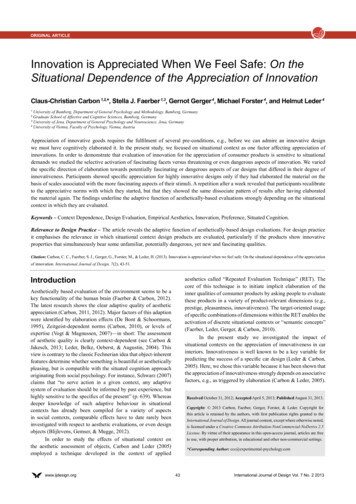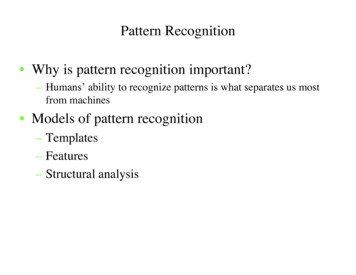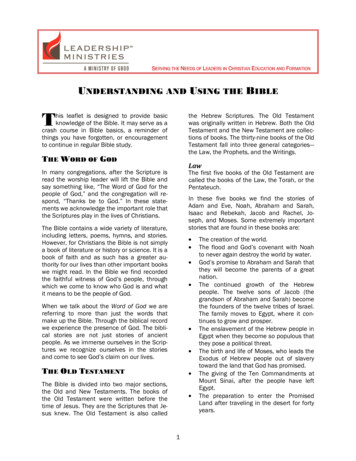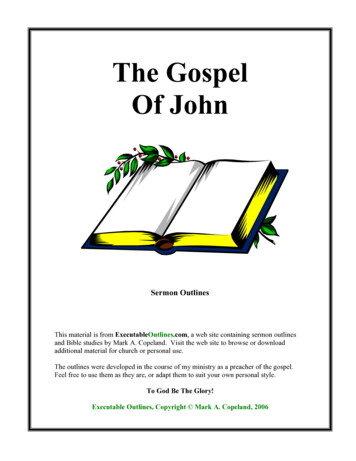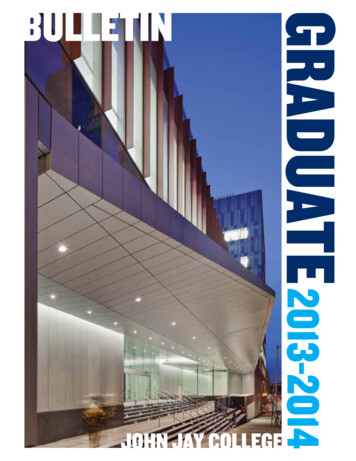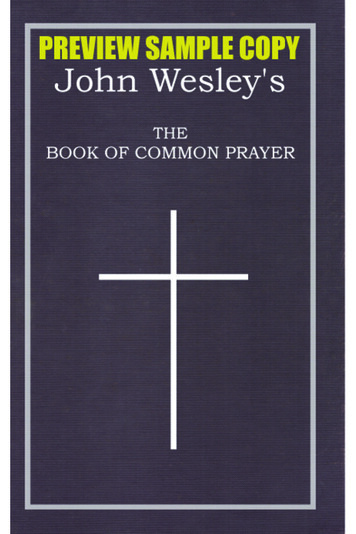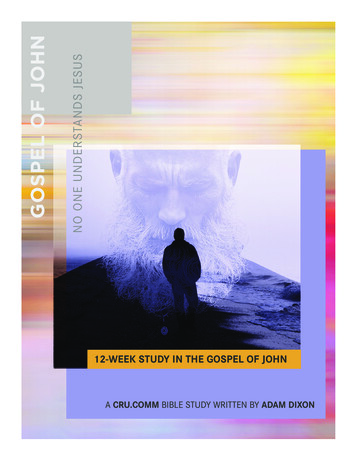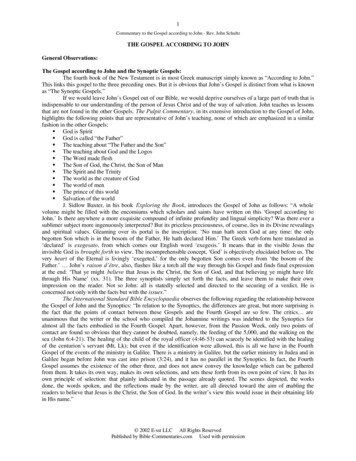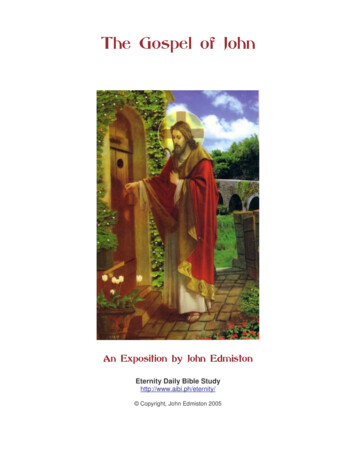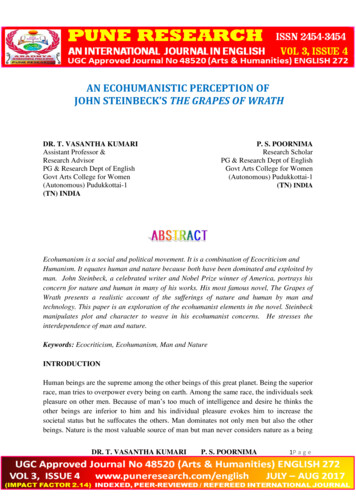
Transcription
AN ECOHUMANISTIC PERCEPTION OFJOHN STEINBECK’S THE GRAPES OF WRATHDR. T. VASANTHA KUMARIAssistant Professor &Research AdvisorPG & Research Dept of EnglishGovt Arts College for Women(Autonomous) Pudukkottai-1(TN) INDIAP. S. POORNIMAResearch ScholarPG & Research Dept of EnglishGovt Arts College for Women(Autonomous) Pudukkottai-1(TN) INDIAEcohumanism is a social and political movement. It is a combination of Ecocriticism andHumanism. It equates human and nature because both have been dominated and exploited byman. John Steinbeck, a celebrated writer and Nobel Prize winner of America, portrays hisconcern for nature and human in many of his works. His most famous novel, The Grapes ofWrath presents a realistic account of the sufferings of nature and human by man andtechnology. This paper is an exploration of the ecohumanist elements in the novel. Steinbeckmanipulates plot and character to weave in his ecohumanist concerns. He stresses theinterdependence of man and nature.Keywords: Ecocriticism, Ecohumanism, Man and NatureINTRODUCTIONHuman beings are the supreme among the other beings of this great planet. Being the superiorrace, man tries to overpower every being on earth. Among the same race, the individuals seekpleasure on other men. Because of man’s too much of intelligence and desire he thinks theother beings are inferior to him and his individual pleasure evokes him to increase thesocietal status but he suffocates the others. Man dominates not only men but also the otherbeings. Nature is the most valuable source of man but man never considers nature as a beingDR. T. VASANTHA KUMARIP. S. POORNIMA1P a g e
and also the most important source of human lives. On the part of humanistic approach mankills and dominates one another for his luxurious life style.Ecocriticism is a study of relationship between literature and nature. It opposes theexploitation of nature as well as men. The term ‘ecocriticism’ was first introduced byWilliam Rueckert in World Literary Association in USA in the year 1970. Later CheryllGlotfelty dedicated a complete book for ecocriticism, The Ecocriticism Reader: Landmark inLiterary Ecology. While ecocriticism has its mainstream discipline, many interdisciplinaryapproaches are developing day by day. Each has its own focus like relating nature withwomen in particular and human in common.Humanism and ecology combines to form Ecohumanism. Ecohumanism focuses on human’sneeds, interests and values. It stresses man’s dependence on nature for their dwelling purpose.It argues that human beings cannot survive without nature. Nature bestows all that it has tohumans while humans in turn does only harm. Ecohumanists stresses mutual coexistence ofman and nature.During early 1930s, a severe drought led to massive agricultural failure in southwest part ofAmerica mainly in Oklahama and California. Because of the absence of rain, farmers whocultivated crops in such areas were greatly affected and were forced to leave their lands. Inthe following years of World War II huge dust storms blew across the sea causing death tonumber of people who were caught. The afflicted region was called as ‘Dust Bowl’. Thedrought led to death of many farmers and their families. Hence, the era was called as Greatdepression era. The landowners were unable to recover their investment on crops, so theremaining farmers and their families were forced to leave their land. They all fled to thenearby farming place California. Soon, California was filled with huge number of migrantworkers whose utmost need was mere survival. They were forced to face one problem afteranother. As the farm country became overcrowded, job and food were scarce. Many migrantworkers starved to death.John Steinbeck is a prolific writer of American literature. He has written sixteen novels ofwhich most of the novels depicts his concern over man and nature. Being a humanist, hestresses that every man is equal and every man should enjoy equal rights. Steinbeck went onseveral trips to record the actual situation of a great crisis that was killing many migrants inhis country. To get first hand information of migrant workers and their family, Steinbecklived with an Oklahama farmer family. He accompanied with them in their journey toCalifornia. He observed their life and hardships. Later, he portrayed it realistically in hiswriting and gave form to his novel The Grapes of Wrath which won him the Nobel Prize forLiterature in 1962.DR. T. VASANTHA KUMARIP. S. POORNIMA2P a g e
The Grapes of Wrath is such a striking novel that it won Steinbeck many awards and prizes.The novel is not a mere social protest but a parable. As it was published at the time ofDepression era and its inception was sensational. Though the specific crisis that he dealt inthe novel no more exists nevertheless the novel loses its appeal and success. Steinbeck hadclose association with Edward Rickets, a marine biologist. Thus, he had an attitude to lookover man in a biological view. He relates human beings; his characters to plants and animals.He has a firm belief in the spiritual comfort that nature offers and encourages earth-foundedoptimism.The post-depression novels or trio of Steinbeck namely In Dubious Battle, Of Mice and Menand The Grapes of Wrath deal with proletarian matter. Of these three novels, The Grapes ofWrath provides a faithful description of the critical period in American history. The Joads,the protagonists of The Grapes of Wrath stand for all of the Dust bowl farmers. They endurea series of difficulties in social, political and economic level. Shortage of rainfall results indrought which becomes worse. Crops are failing and the banks evict family from their farms.They bring in tractors that can do work of fifteen families at a same time: “The owners of theland came onto the land, or more often a spokesman for the owners came. . . .And at last theowner men came to the point. The tenant system won’t work anymore. One man on a tractorcan take place of twelve or fourteen families. Pay him a wage and take all the crops (TGOW21)”. Man turns inhuman to his fellow men. Men in form of land-owners, landlords andbankers who try to hoard more and more money seize the hope of life of their tenants.Ecohumanists argue that the modern science and technology has killed the humanity in man.Man has become more materialistic that he buried his humanity in the deep earth. Thelandowners wanted to replace the tenants with a single machine that they could save theirmoney. Humanity in them is long dead and they could not see that the tenants’ life dependson that little wages that they offer. Thus, not only drought and poverty could be blamed asthe reason for the people’s migration to the other land, but also the man and technologywhich forced them to leave their land. Steinbeck describes the modern machines as monstersin the following lines.The tractors came over the roads and into the fields . . . Snubnosed monsters, raisingthe dust . . . . The man sitting in the iron seat did not look like a man; glove, goggled,rubber dust mask over nose and mouth, he was a part of the monster, a robot in theseat. He could not see the land as it was, he could not smell the land as it smelled; hisfeet did not stamp the clods or feel the warmth and power of the earth. (TGOW 24)DR. T. VASANTHA KUMARIP. S. POORNIMA3P a g e
As they have nothing more to lose, the Joads decides to move westward to the promising landof California. They plan to migrate to the other country to find a new home, new hope andnew livelihood. Tom Joad, the elder son of Joad, returns to his farm after four years of prisonsentence. He meets Jim Casy who was a preacher and helped Tom to join labour organisationin the later part of the novel. Tom finds his farm deserted and learns from a neighbour that hisfamily plans to move Westward from Oklahama to California. Tom receives a warmwelcome from his family members. The elder man of the family is Grampa Joad. He is thefounder of Joad’s farm. Even when there is no hope for their survival, he is reluctant to leavethe farm where he has lived and uprooted. The family drugs him to take him along with thembut soon he dies.Steinbeck uses the symbol of Joad’s dog which met an accident soon after they leave theirfarm to relate the Grampa Joad’s death which was to take place next. He dies of a stroke as ifhe could not bear to leave the land in which he lived for so many years. Steinbeck illustratesby his death that it will be real hard for a man who loved his land as like his fellow being toabandon and leave it behind. The Joad’s family is forced to face much more hardships ontheir journey. A filling station operator demands double amount of money. The tenantfarmers who were desperate to leave the land paid willingly, to the salesman delight.Joads could see that they are not the only people moving to California. Many peopleapproach the city in a hope that they could get job and decent wages. But the countrybecomes overcrowded by migrants. All farmers face many difficulties on their journey.Greediness of the employers rises as they have more workers than their need. So they givethem very low wages with which they could only survive and could not attain any profit. Themoney that they earn is spent for buying food in stores which are run by the landowners andhence the prices were also high. The migrants were oppressed and suppressed by the landowners. They were also kept under surveillance that no one could escape from their miserablesituation. The owners of the farm were inhumane. They rob both the wealth of the land andstrength of the workers. Man who must live harmonious with land rather conquers it as heseizes it.Tom Joad manages to escape from the farm and meets Jim Casy, his old friend. Jim who hasleft his job of preaching, is now engaged in organising labourers to fight for their rights.Eventually he generated many enemies among the landowners. The landowners paid hugeamount of money to the police to kill him. Police hunts him and kills him. Out of rage, Tomkills the police and manages to escape. At the end of the novel, he took the job of organisingthe workers to fight against landowners.DR. T. VASANTHA KUMARIP. S. POORNIMA4P a g e
CONCLUSION:In our ecosphere all organisms including human beings are dependent on nature. But manfails to understand such truth. By the name of science and technology, he tries to overpowernature. Such an act will leave him only to his own destruction. Steinbeck’s charactersespecially the farmers in The Grapes of Wrath love their environment and nature. But theyare evacuated because of landowners greediness. They were deprived of land to live. With theportrayal of Joad’s family and their hardships, Steinbeck has presented ecohumanistic stancesto prove the interdependence of man and nature.Steinbeck, John. The Grapes of Wrath. New York: Viking Press, 1939. PrintGlotfelty, Cheryll, and Harold Bloom, eds. The Ecocriticism Reader: Landmarks in LiteraryEcology. London: The University of Georgia Press, 1996. Print.Ferrel, Keith, ed. John Steinbeck: The Voice of the Land. New York: The Rowman &Littlefield Publishing Group, Inc., 1986. Print.DR. T. VASANTHA KUMARIP. S. POORNIMA5P a g e
portrayal of Joad’s family and their hardships, Steinbeck has presented ecohumanistic stances to prove the interdependence of man and nature. Steinbeck, John. The Grapes of Wrath. New York: Viking Press, 1939. Print Glotfelty, Cheryll, and Harold Bloom, eds
